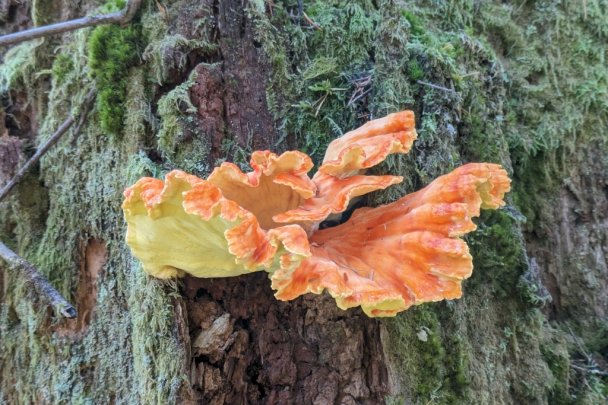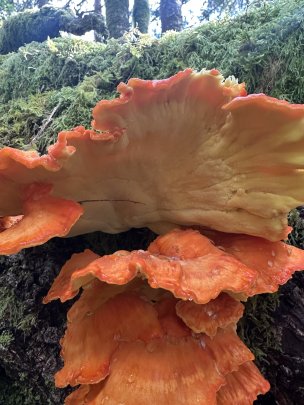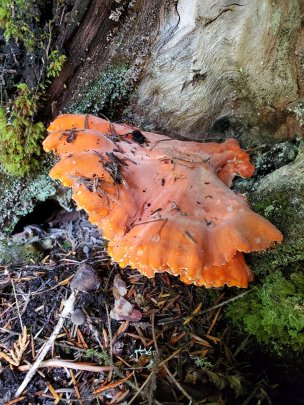Laetiporus conifericola
🏷️ Description
If you're wandering through the coniferous forests of western North America and spot a stunning, bright orange shelf fungus growing on a fir or spruce tree, you might have just encountered Laetiporus conifericola! This striking polypore, commonly known as the western Chicken of the Woods, is a fascinating, vibrant, and sometimes edible fungus with a complex history and a few important precautions.
🏔️ Meet Laetiporus conifericola: Belonging to the Fomitopsidaceae family, L. conifericola is found from California to Alaska, growing as a plant pathogen and later as a saprotroph on fir, spruce, and hemlock trees. This species was first formally described in 2001 by mycologists Harold H. Burdsall and Mark T. Banik, but it had long been mistaken for its eastern relative, Laetiporus sulphureus, which prefers hardwood hosts.
💥 A Mighty Wood Destroyer:Beyond its eye-catching appearance, L. conifericola plays a vital ecological role. This aggressive wood decay fungus breaks down conifer wood, returning nutrients to the forest floor. It starts as a parasite on living trees but continues as a saprotroph after the host dies, helping in the natural decomposition process.
🔎 Identification
🎨 Appearance
-
Forms large, overlapping shelves, sometimes up to 60 cm (24 in) wide
-
Cap color varies from bright orange to salmon orange, with a sulfur-yellow pore surface underneath
-
Flesh is firm and pale yellow when young, becoming chalky and white with age
-
Spores are egg-shaped, smooth, and translucent, measuring 6.5–8.0 × 4.0–5.0 µm
🌲 Growth & Habitat
-
Found exclusively on conifers such as Douglas fir and Sitka spruce
-
Grows in large clusters on dead or dying trees, stumps, and snags
-
Late summer through fall is the prime fruiting season
🍽️⚠️ Edibility & Culinary Caution
Laetiporus conifericola is considered edible when young, but there are a few important considerations:
✅ Best when young and tender—older specimens become tough and unpalatable
✅ Always thoroughly cook before eating, as raw consumption can cause digestive distress
✅ Taste varies—some find it delicious, while others find it unpleasant
❌ Avoid if growing on toxic trees like yew (Taxus baccata), as it may absorb deadly toxins
❌ Can cause allergic reactions or gastrointestinal upset in some individuals—try only a small amount first
👀 Look-Alikes
🟠 Laetiporus gilbertsonii – Found on hardwoods (oak, eucalyptus), similar in appearance but often less orange
🟡 Laetiporus sulphureus – Eastern North American species growing on hardwoods
📜 Synonyms
-
Laetiporus conifericola
-
Laetiporus huroniensis
Photo sources:
Photo 1 - Author: Hilary Rose Dawson (CC BY 4.0)
Photo 2 - Author: Jan Smith (CC BY 4.0)
Photo 3 - Author: Kieran Hanrahan (CC BY 4.0)
Photo 4 - Author: Jonathan Curley (CC BY 4.0)




